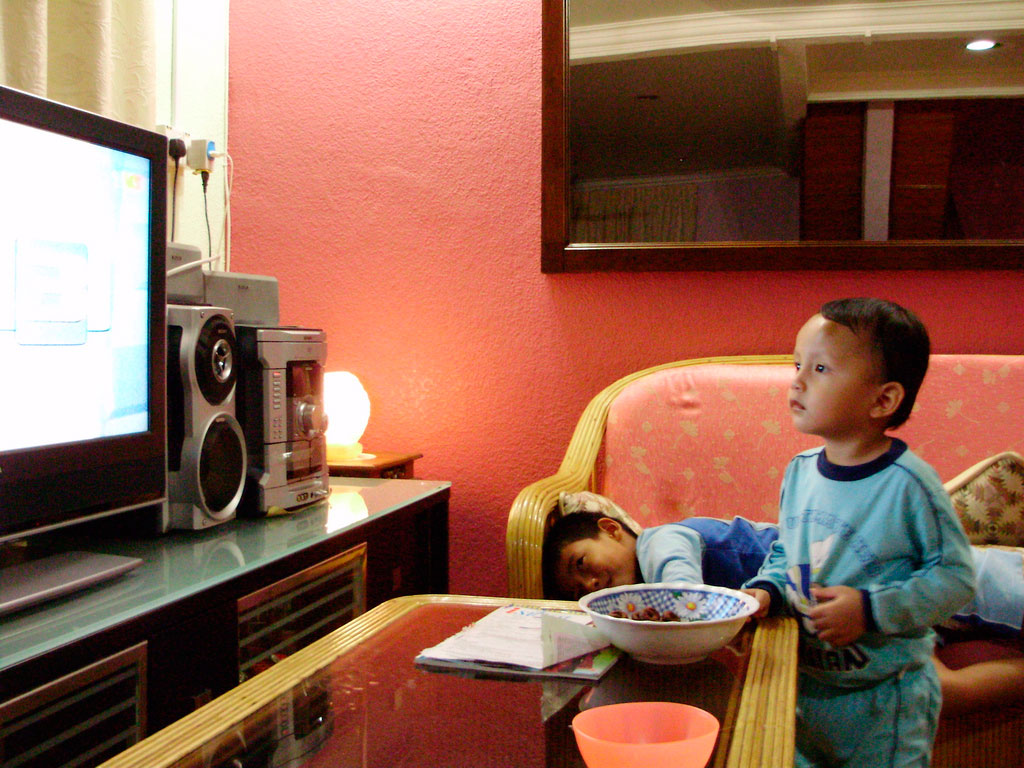 If you were born after 1990, are the parent or grandparent of someone born after 1990, or a children’s media producer of any age, Ready To Learn (RTL) has probably touched your life. Launched in 1994, RTL is a U.S. Department of Education-funded initiative that provides about $25 million annually for the creation of educational media (TV, computer games, apps, and more) designed to promote school readiness. RTL funding has gone to the production of legacy media properties that existed long before the initiative, like Sesame Street, as well as newer media properties, like Ready Jet Go! RTL media targets all children, with special outreach to low-income and racial-ethnic minority populations. Most U.S. preschoolers have watched RTL TV or played RTL games, with especially high rates of RTL media consumption in at-risk communities.
If you were born after 1990, are the parent or grandparent of someone born after 1990, or a children’s media producer of any age, Ready To Learn (RTL) has probably touched your life. Launched in 1994, RTL is a U.S. Department of Education-funded initiative that provides about $25 million annually for the creation of educational media (TV, computer games, apps, and more) designed to promote school readiness. RTL funding has gone to the production of legacy media properties that existed long before the initiative, like Sesame Street, as well as newer media properties, like Ready Jet Go! RTL media targets all children, with special outreach to low-income and racial-ethnic minority populations. Most U.S. preschoolers have watched RTL TV or played RTL games, with especially high rates of RTL media consumption in at-risk communities.
When I was completing my doctoral dissertation at Northwestern University, I wanted to know whether RTL media is really working. In a research study that I recently had published in the academic journal Child Development, I asked whether exposure to RTL media had a positive impact on young children’s early literacy skills. To answer this question, I compiled every evaluation of RTL media I could get my hands on. In total, I gathered together 45 evaluations conducted over RTL’s 20+ year history and involving 24,624 kids ages 2-8. About two-thirds of these evaluations were led by researchers who received sub-contracts from RTL grant recipients (referred to later in this post as RTL-funded researchers), and the remaining evaluations were conducted independently. I extracted statistical information from these evaluations to conduct a meta-analysis – a type of review that averages across many different research studies to yield robust findings about how well something works.
Overall, I found that RTL media were indeed successful in promoting early literacy, especially vocabulary and alphabetics (knowledge of English letter sounds). Exposure to RTL media resulted in about 8 percentiles or 1.5 months of literacy development above and beyond typical growth. This is about equivalent to Head Start’s impact on children’s early learning (although of course Head Start also provides a host of services not found in media, like medical care). Effects were about the same regardless of whether kids watched RTL shows or played RTL computer games/apps. The media were more effective for preschool than elementary school students and for Native Americans (an RTL target population in some markets). Below, I share additional findings from this study and discuss implications for producers, research professionals, policymakers, and parents.
Producers
Producers are doing a great job making educational content, but there’s a need to continue creating media that promotes and reinforces the same kinds of core literacy skills already featured in RTL media (knowledge of the letters and sounds of the alphabet, vocabulary, and knowledge of basic English writing conventions). Many RTL media properties that received grant funding at one point and were successful at helping children learn are no longer in production.
There’s also room to focus on other literacy skills not covered as well in existing RTL assets, or to focus on promoting literacy for school-age children. I found in this study that RTL media was not consistently successful at promoting narrative comprehension, which is a tricky skill for kids to master before elementary school. Media promoting narrative comprehension—perhaps simply by featuring storylines with a beginning, middle, and end—might fill a gap in the marketplace. During the current RTL grant cycle, producers are focusing on promoting an appreciation for non-fiction or informational texts—which is an area rarely covered in older RTL assets.
Research Professionals
The reviewer critiques I received while publishing this study made me realize that there may be value in RTL-funded researchers being more transparent about their work. I know from reading myriad RTL evaluations that the average study led by RTL-funded researchers was conducted by an experienced team, resulting in a detailed report in the 50- to 100-page range. It’s that level of detail that made this study possible. However, the Child Development reviewers were skeptical about the quality of RTL-funded research, complaining that studies could be hard to track down and often not indexed in traditional academic databases. They were concerned that something fishy might be afoot—that RTL-funded researchers might be hiding unfavorable results or entire evaluations. Posting hypotheses and measures in advance of conducting studies might assuage these concerns. It would also be helpful if all RTL research—across grant cycles and conducted by disparate groups—was saved in a unified database. This could make it easier for outsiders to track down and potentially benefit from the research.
It would further be beneficial if more researchers with independent sources of funding chose to conduct research studies using RTL media as stimuli. Such research would provide stronger evidence for or against the continued funding of the RTL initiative. There’s no reason to fear doing so. This study demonstrates that RTL media can be effective and that RTL research is publishable and can be theoretically impactful.
Policymakers
For those making or advising educational policy, the main takeaway of this study is clear: RTL should continue to be funded. RTL media are reaching the majority of American preschoolers and have positive impacts on early literacy. RTL is able to accomplish this with a relatively tiny budget compared to other educational expenditures (the annual budget for Head Start is over $9 billion, compared to RTL’s ~$25 million).
In crafting the RTL calls for proposals, it would also be helpful for policymakers to continue to allow and encourage producers to focus on the same skills across multiple grant cycles. The 2005-2010 RTL grant cycle focused on literacy, 2010-2015 focused on literacy and math, and 2015-2020 focused on literacy and science. In this study, RTL’s effects on literacy increased across grant cycles. I suspect content producers may have become more experienced at promoting literacy over time. I further guess producers would continue honing their craft to develop continuously stronger mathematics and science content if incentivized to do so over extended periods of time.
Parents
If your child is going to watch TV or use screen media, choosing content funded by RTL is a pretty safe bet. The odds are good this content will be educationally beneficial. A lot of RTL’s TV content airs on PBS. PBS provides information about the current grant-funded media properties here, and the Corporation for Public Broadcasting maintains this landing page with the latest RTL news.
If you’re able, it’s also immensely helpful to watch educational TV or play educational apps/computer games with your child to support their learning. My study further suggests that kids may benefit from doing learning activities related to the educational messages in this media. Many RTL-funded TV shows offer activities that parents or teachers can lead to complement and extend children’s learning from the media. Some shows even have an activity or set of activities corresponding to every single episode. Activities for shows airing on PBS can be found here and here. Just click on your child’s favorite show to see if it has show-related activities.
In conclusion, consuming RTL media content is a valuable use of children’s time, especially for preschool-age children, and initiatives such as RTL are a wise investment of U.S. taxpayer dollars. The findings from this massive dataset underscore RTL’s value. That said, there’s still more work for us to do as producers, research professionals, policymakers, and parents.
For more on this study, check out the full scientific article.
 Lisa B. Hurwitz, PhD conducted the research described in this blog post while working at the Center on Media and Human Development at Northwestern University. She is currently completing a postdoctoral fellowship at the Center on Media and Child Health at Boston Children’s Hospital/Harvard Medical School, and will soon join Lexia Learning as a Lead Researcher. Dr. Hurwitz’s research leverages evaluation theory to study children’s learning from media/technology and related policy questions. Beyond the study discussed in this blog post, her other scholarship has been published in peer-reviewed journals such as New Media & Society, Computers in Human Behavior, and Health Communication; received recognition from the International Communication Association and Society for Research on Child Development; and been featured in news outlets, including the Chicago Tribune and Education Week.
Lisa B. Hurwitz, PhD conducted the research described in this blog post while working at the Center on Media and Human Development at Northwestern University. She is currently completing a postdoctoral fellowship at the Center on Media and Child Health at Boston Children’s Hospital/Harvard Medical School, and will soon join Lexia Learning as a Lead Researcher. Dr. Hurwitz’s research leverages evaluation theory to study children’s learning from media/technology and related policy questions. Beyond the study discussed in this blog post, her other scholarship has been published in peer-reviewed journals such as New Media & Society, Computers in Human Behavior, and Health Communication; received recognition from the International Communication Association and Society for Research on Child Development; and been featured in news outlets, including the Chicago Tribune and Education Week.



